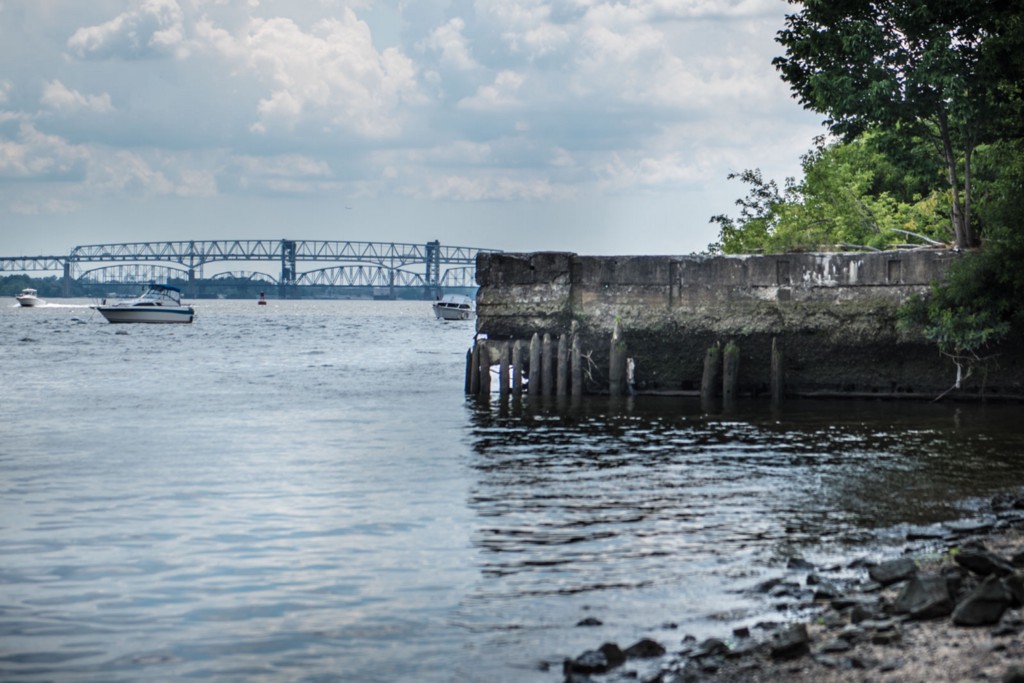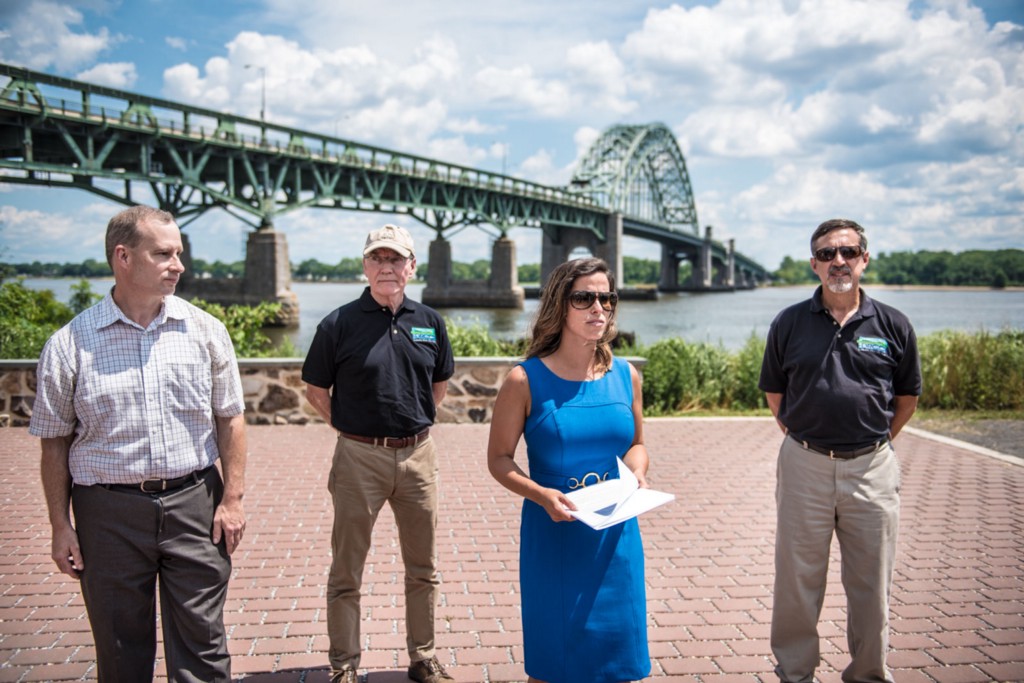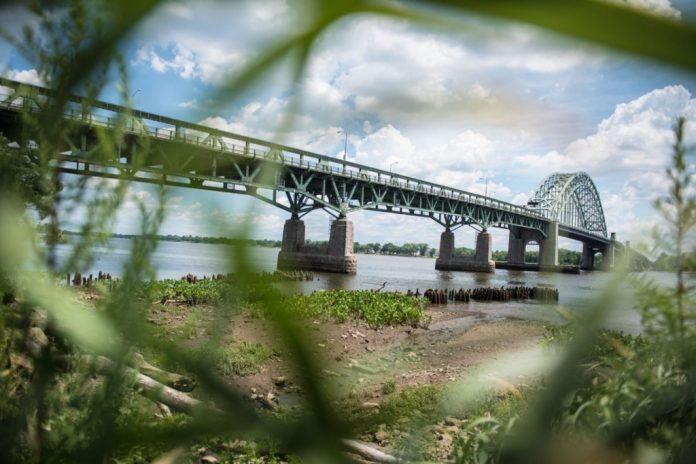MARIA YOUNG / TIMES PHOTO
Public officials cut a ribbon to open 4.5-acre Lardner’s Point Park on the Delaware River in Tacony in 2012, signaling a new era of public recreation in the neighborhood. But the natural restoration of the precious waterfront remains a work in progress.
And flooding is still a formidable threat.
Last month, officials from the Delaware River City Corporation and the Pew Charitable Trusts led a tour of the Lardner’s Point wetlands to show how they are being converted into a sustainable “living shoreline” and to encourage the community to advocate for similar nature-based solutions for other urban shorelines across the country.
Standing on a fishing and observation pier just south of the Tacony-Palmyra Bridge, Laura Lightbody, a Washington, D.C.-based project director for Pew, said that her focus is on “creating more prepared communities in the face of flood disasters.”
As of early July, there had been 43 major disasters across the nation declared by the federal government in 2016. Among those, 26 were flood related. And that was weeks before prolonged rainfall caused widespread flooding in at least 20 southern Louisiana parishes.
Meanwhile, about 14 percent of shorelines in the U.S. have been hardened by use of concrete structures, bulkheads or seawalls, also known as gray infrastructure.
“We are working through projects like this to make sure that number doesn’t grow,” Lightbody said.
Research conducted by Northeastern University’s Marine Science Center in collaboration with Pew has shown that hardened shorelines are less resilient to major storm events than those that employ natural features such as marshes and native vegetation, which also reduce erosion and promote the growth of natural habitats and wildlife populations. Natural shorelines recover from storms quicker, too.
In recent months, Lightbody has coordinated Pew’s advocacy for a proposed change in the U.S. Army Corps of Engineers’ permitting process for living shorelines. A public comment period ended on Aug. 1, but the Corps has yet to formally adopt the proposal.
The Corps holds jurisdiction over waterfront construction under federal law. Lightbody said that under current protocols, it’s easier and faster for an applicant to obtain a permit to install a seawall or bulkhead than it is for a living shoreline. The new protocol could streamline permitting from 215 days to as few as 45 days, according to a July 6 article in Scientific American.
“The living shoreline piece is a part of what we’re pushing as a non-structural, nature-based method that is a lot less costly,” said Lt. Gen. Thomas Bostick, the former Corps chief engineer, according to Scientific American. “It helps with our environmental focus; it helps us with the endangered species, perhaps. All of that is a natural way that we can reclaim some of our land and take the focus off of expensive infrastructure.”
The Lardner’s Point restoration is an example of what can be accomplished in just a few years, even in urban settings where decades of industrialization, erosion, introduction of non-native species, dumping and neglect have taken a large toll.
The nonprofit DRCC employed a Baltimore-based ecological consultant and engineering firm, Biohabitats, to manage the restoration. DRCC has already spent $1.6 million on the project and is raising more money to expand the natural habitat.
In the 1920s, a ferry terminal was there, said DRCC Project Manager Jim Fries. In the late 19th and early 20th centuries, heavy industrial firms like Disston Saw Works and Tacony Iron and Metal Company dominated the riverfront in the area. The Tacony-Palmyra Bridge opened to vehicle traffic in 1929.
Today, Lardner’s Point is a trailhead park along the North Delaware Riverfront Greenway, which traverses the Delaware waterfront for 11 miles from Port Richmond to the Poquessing Creek. The greenway, in turn, is part of the East Coast Greenway, a 3,000-mile bicycle trail from Florida to Maine. Portions of the local and national trail systems are still in development. DRCC is supported by the city and the William Penn Foundation, according to Executive Director Tom Branigan.
Ed Morgereth, a senior ecologist and principal for Biohabitats, said that restorers repurposed many large rocks that they found in the area, as well as discarded concrete chunks, to create breakwaters just off the shoreline. The new underwater sill lessens the erosive impact of the tidal river.
Workers and volunteers, including community members and teens from the Philadelphia Wooden Boat Society, have met some challenges along the way. One of the first tasks was to remove non-native or invasive plants from the shore so that native species could be reintroduced. Certain plants have root systems that protect the soil from erosion.
Litter was also a problem, particularly empty plastic bottles that tend to scour the fragile vegetation, Morgereth said. Canada geese are a big threat, too. They like to feed on certain seeds, so workers had to use trial and error to learn what the birds will eat and what they won’t. Initially, vandals posed a problem as they destroyed some of the wooden frames that were being used to support seedlings. Morgereth and his team rebuilt them with beefier materials.
Since establishing the new wetlands in 2012, the plants and wildlife have grown and multiplied. Some shrubs stand 15 feet high. Biohabitats returns regularly for monitoring. The shoreline has developed a defined marsh zone at the water’s edge, a secondary zone of willows and dogwoods farther up the slope and then what the ecologists describe as a meadow and coastal forest as the shore transitions into the park’s recreational areas. ••

MARIA YOUNG / TIMES PHOTO

Preparing for the flood: Officials from the Delaware River City Corporation and the Pew Charitable Trusts led a tour of the Lardner’s Point wetlands to show how they are being converted into a sustainable “living shoreline.” Pictured are (from left) Ed Morgereth, Tom Branigan, Laura Lightbody and Jim Fries. MARIA YOUNG / TIMES PHOTO





